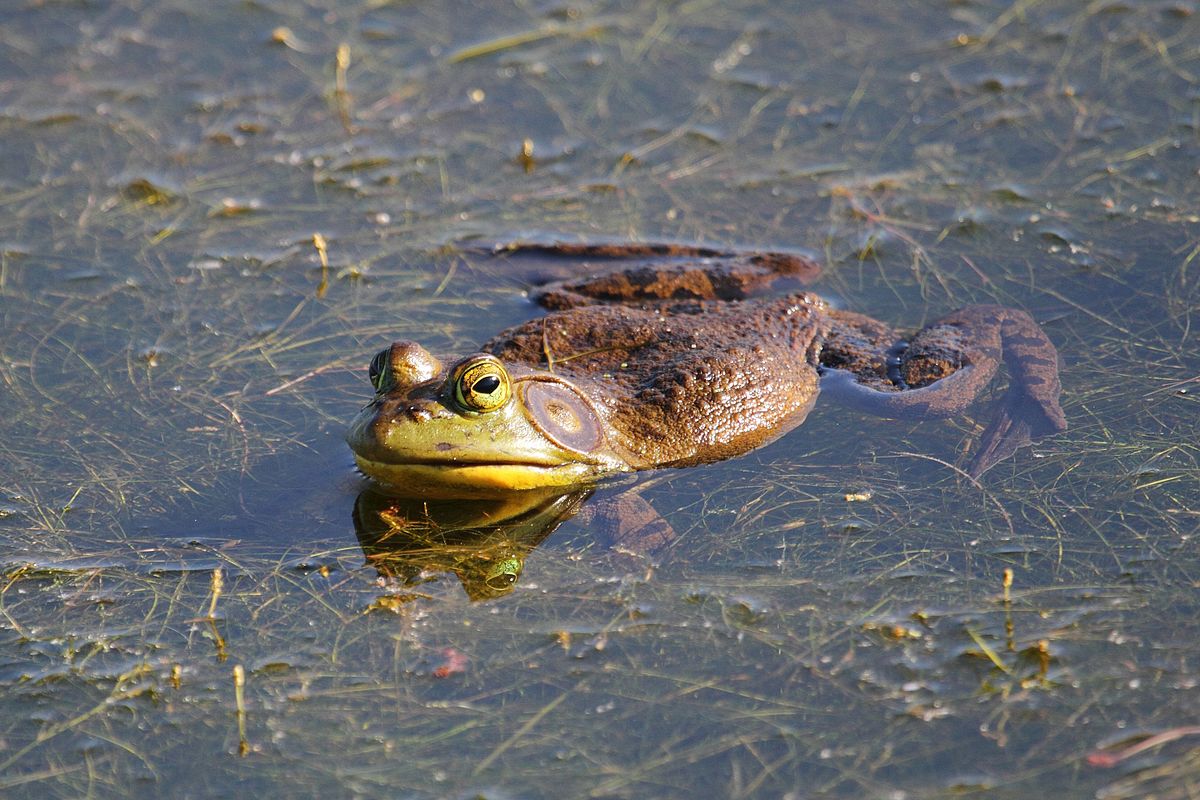American Bullfrog

American Bullfrog
(Lithobates catesbeianus)
Tags: Aquatic
Identification and Reproduction
Identification:
- American bullfrog has a large robust body that can reach 20 centimeters in length.
- They are green or brown in colour and have yellow or pale cream to white throats.
- The front toes are not webbed but their back legs are fully webbed.
- The baritone call of the bullfrog is so deep and resonant, it resembles the mooing of a cow.
- Only males emit this trademark "jug-o-rum" bellow, and their choruses can be heard during the day or night during mating season.
- Look for the circular “ear drums” on the side of the head behind their eyes.
- They can weigh up to 1.5 lb.
Reproduction:
- This species breeds from the late spring to early fall.
- Males are territorial. Mating success is influenced by the quality of the territory.
- Females lay one or two clutches per season with average clutch size of 12,000 eggs.
- As prolific producers, clutch sizes can reach upto 20,000 eggs.
- Clutches are laid as a film on the water surface with eggs hatching approximately 5 days later.
- Tadpoles can be very large, 125-150 mm.
- Full metamorphosis usually takes 1 year, larvae will overwinter in ponds and larval survivorship is about 18%.
- This species typically reaches sexual maturity one year after metamorphosis.
Habitat & Ecology
- They are among the most wide-ranging of all North American amphibians, found in freshwater ponds, lakes, and marshes.
- Average lifespan in the wild is 7 to 9 years
- They are aggressive predators and will consume anything they can fit into their mouths, this includes insects, birds, mammals, reptiles and other frogs.
- Currently, bullfrogs are established in the Fraser Valley and on the southeastern part of Vancouver Island.
Impacts
- American bullfrogs displace native frogs in habitats they invade by outcompeting and depleting the food sources of native frogs.
- They also spread infectious diseases to native amphibians.
- They are causing the decline of the native red-legged frog and pacific chorus frog populations.
Management
- Do not possess, breed, transport or release American Bullfrogs anywhere in BC.
- Do not collect or move any tadpoles (regardless of species), and do not move frogs from one waterbody to another - this helps them spread.
- Humane killing of bullfrogs may be utilized to control the spread and limit their damage to ecosystems.
Resources
For further details on American Bullfrog control please refer to the Metro Vancouver Best Management Practices for the American Bullfrog (pg. 15-21)
Download the Metro Vancouver Factsheet on American Bullfrog here.
For more information on the life history and to listen to the American bullfrog call check out the Virginia Herpetological Society.
For recommended actions and methods for control of American bullfrogs please refer to BC SPCA's Wildlife Control Best Practices here.
Download the Fraser Valley Conservancy's dichotomous key for Frogs and Toads of BC's South Coast here.
Header photo (Carl D. Howe).




